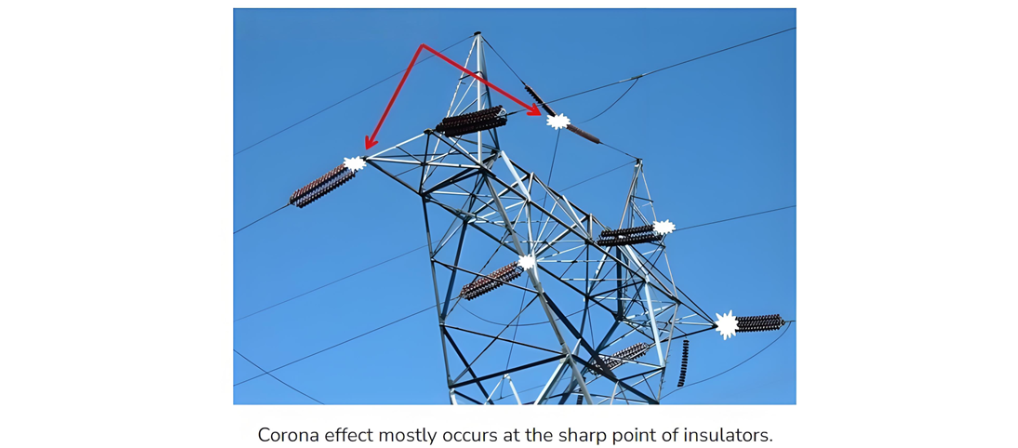Definition: The corona effect refers to the phenomenon where the surrounding air around a conductor ionizes, resulting in a luminous glow accompanied by a hissing noise.
Air serves as a dielectric medium between transmission lines. In other words, it acts as an insulator between current - carrying conductors. When the voltage induced between conductors is of an alternating nature, a charging current flows between the conductors. This charging current increases the voltage of the transmission line.
The electric field intensity also increases due to the charging current. When the electric field intensity is less than 30 kV, the current induced between the conductors can be neglected. However, if the voltage rises beyond 30 kV, the air between the conductors becomes charged and begins to conduct. Sparking occurs between the conductors until the insulation properties of the conductors completely break down.

Contents
- Corona effect
- Corona Formation
- Factors affecting corona
- Disadvantages of corona discharge
- Minimizing corona
- Important points
Corona Formation
Air is not a perfect insulator. Even under normal conditions, it contains numerous free electrons and ions. When an electric field is established between conductors, these ions and free electrons experience a force. As a result, they are accelerated and move in opposite directions.
During their motion, charged particles collide with each other and with slow - moving uncharged molecules. Consequently, the number of charged particles increases rapidly, enhancing the conductivity of the air between the conductors until a breakdown occurs. At this point, an arc is established between the conductors.
Factors affecting corona
The following are the factors influencing the corona:
- Effect of supply voltage: Higher supply voltage leads to greater corona loss in the lines. In low - voltage transmission lines, the corona is negligible because the electric field is insufficient to sustain ionization.
Condition of conductor surface: A smooth conductor results in a more uniform electric field compared to a rough one. Conductor roughness, caused by dirt, dust deposition, scratching, etc., reduces corona loss in transmission lines.
- Air Density Factor: Corona loss is inversely proportional to the air density factor. That is, corona loss increases as the air density decreases. Transmission lines in hilly areas may experience higher corona loss than those in plains because the air density is lower in hilly regions.
- Effect of system voltage: The electric field intensity around the conductors depends on the potential difference between them. A higher potential difference leads to a higher electric field intensity and, consequently, more pronounced corona. Corona loss increases with an increase in voltage.
- Spacing between conductors: If the distance between two conductors is much greater than the conductor diameter, corona loss occurs. When this distance is extended beyond a certain limit, the dielectric medium between them diminishes, reducing the corona loss.
Disadvantages of corona discharge
The adverse effects of corona are as follows:
- Power loss indication: A glow appears around the conductor, which is a clear sign of power loss occurring on it.
- Audio noise and power loss: The corona effect generates audio noise, and this noise is accompanied by power loss on the conductor.
- Conductor vibration: The corona effect causes the conductor to vibrate, which can affect its structural integrity over time.
- Corrosion due to ozone generation: Corona generates ozone, which in turn makes the conductor susceptible to corrosion, shortening its lifespan.
- Non - sinusoidal signals and voltage drops: It produces non - sinusoidal signals, leading to non - sinusoidal voltage drops along the line, which can disrupt the normal operation of electrical equipment connected to the line.
- Reduction in line efficiency: The power loss caused by corona significantly reduces the overall efficiency of the transmission line.
- Radio and TV interference: The corona effect can interfere with radio and television signals, causing disruptions in communication and broadcasting services.
Minimizing corona
Since corona reduces the efficiency of transmission lines, minimizing it is crucial. The following approaches can be considered to control corona:
- Increasing conductor diameter: Enlarging the diameter of conductors is an effective way to reduce corona loss. This can be achieved by using hollow conductors or steel - cored aluminum conductors (ACSR). These types of conductors not only increase the diameter but also maintain the necessary mechanical strength and electrical conductivity.
- Adjusting line voltage: The voltage of transmission lines is determined by economic factors. While increasing the spacing between conductors can raise the disruptive voltage, this method has practical limitations. For instance, excessive spacing may require more land, increase construction costs, and pose challenges in terms of structural stability.
- Optimizing conductor spacing: Although increasing the space between conductors can increase the voltage drop due to the rise in inductive reactance, proper adjustment of the spacing within reasonable limits can help control corona. A balance needs to be struck between reducing corona and maintaining acceptable voltage levels for power transmission.
Important points
- Disruptive voltage: It refers to the minimum voltage at which the air insulation breaks down, marking the onset of corona. Once this voltage is reached, the air between conductors starts to ionize, leading to the formation of corona.
- Visual critical voltage: This is the minimum voltage at which visible corona becomes apparent. Below this voltage, while corona may still be occurring at a non - visible level, the characteristic glow associated with corona is not observable.